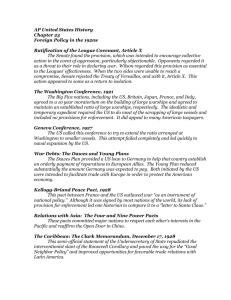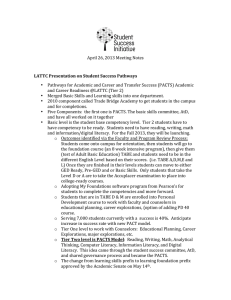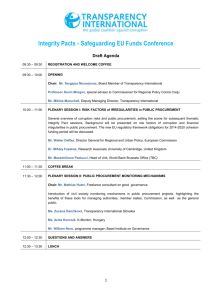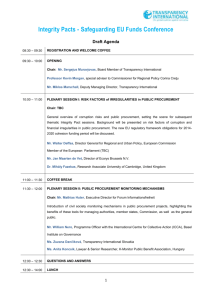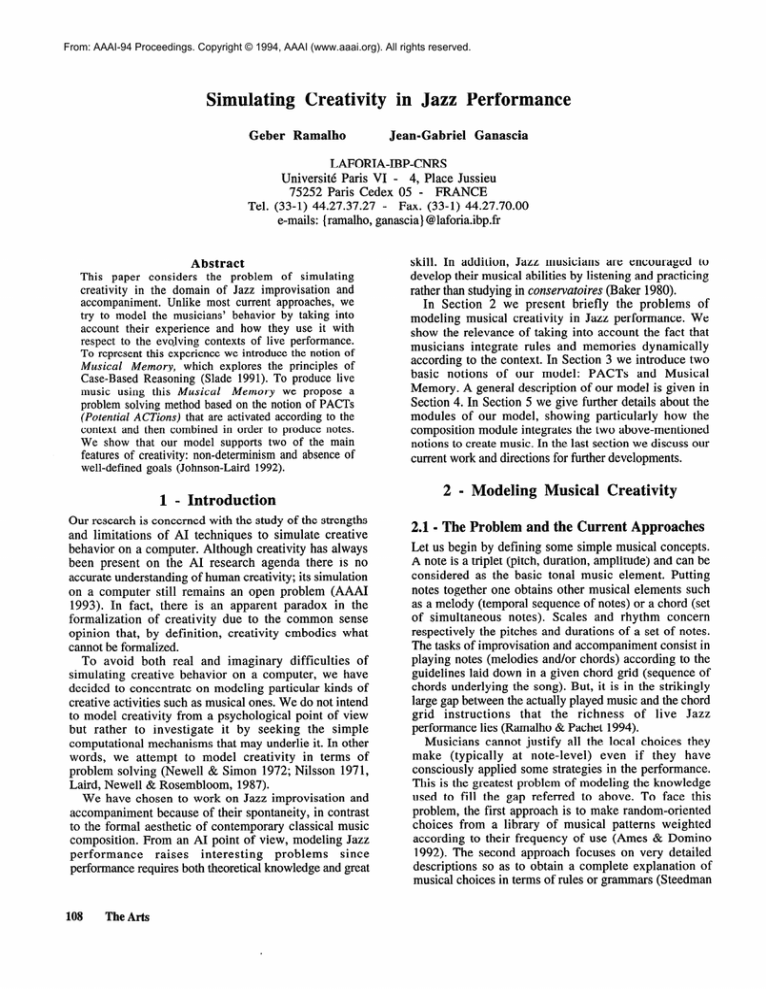
From: AAAI-94 Proceedings. Copyright © 1994, AAAI (www.aaai.org). All rights reserved.
ulating Creativity
Geber
Ramalho
in Jazz Performance
Jean-Gabriel
Ganascia
LAFORIA-IBP-CNRS
Universite Paris VI - 4, Place Jussieu
75252 Paris Cedex 05 - FRANCE
Tel. (33-l) 44.27.37.27
- Fax. (33-l) 44.27.70.00
e-mails: {ramalho, ganascia} @laforia.ibp.fr
Abstract
This paper considers the problem of simulating
creativity in the domain of Jazz improvisation and
accompaniment. Unlike most current approaches, we
try to model the musicians’ behavior by taking into
account their experience and how they use it with
respect to the evo)ving contexts of live performance.
To represent this experience we introduce the notion of
Musical
Memory, which explores the principles of
Case-Based Reasoning (Slade 1991). To produce live
music using this Musical
Memory we propose a
problem solving method based on the notion of PACTS
(Potential ACTions) that are activated according to the
context and then combined in order to produce notes.
We show that our model supports two of the main
features of creativity: non-determinism and absence of
well-defined goals (Johnson-Laird 1992).
1 - Introduction
Our research is concerned with the study of the strengths
and limitations
of AI techniques
to simulate creative
behavior on a computer. Although creativity has always
been present on the AI research agenda there is no
accurate understanding of human creativity; its simulation
on a computer still remains an open problem (AAAI
1993). In fact, there is an apparent paradox in the
formalization
of creativity due to the common sense
opinion that, by definition,
creativity embodies what
cannot be formalized.
To avoid both real and imaginary
difficulties
of
simulating
creative behavior on a computer, we have
decided to concentrate on modeling particular kinds of
creative activities such as musical ones. We do not intend
to model creativity from a psychological
point of view
but rather to investigate
it by seeking the simple
computational mechanisms that may underlie it. In other
words, we attempt to model creativity
in terms of
problem solving (Newell & Simon 1972; Nilsson 1971,
Laird, Newell & Rosembloom,
1987).
We have chosen to work on Jazz improvisation
and
accompaniment
because of their spontaneity, in contrast
to the formal aesthetic of contemporary
classical music
composition.
From an AI point of view, modeling Jazz
performance
raises
interesting
problems
since
performance requires both theoretical knowledge and great
10s
The Arts
skill. In addition, Jazz musicians
are encouraged
to
develop their musical abilities by listening and practicing
rather than studying in conservutoires (Baker 1980).
In Section 2 we present briefly the problems
of
modeling musical creativity in Jazz performance.
We
show the relevance of taking into account the fact that
musicians
integrate rules and memories
dynamically
according to the context. In Section 3 we introduce two
basic notions
of our model: PACTS and Musical
Memory. A general description of our model is given in
Section 4. In Section 5 we give further details about the
modules of our model, showing particularly
how the
composition module integrates the two above-mentioned
notions to create music. In the last section we discuss our
current work and directions for further developments.
2 - Modeling
Musical
Creativity
2.1- The Problem and the Current Approaches
Let us begin by defining some simple musical concepts.
A note is a triplet (pitch, duration, amplitude) and can be
considered as the basic tonal music element. Putting
notes together one obtains other musical elements such
as a melody (temporal sequence of notes) or a chord (set
of simultaneous
notes). Scales and rhythm concern
respectively the pitches and durations of a set of notes.
The tasks of improvisation and accompaniment consist in
playing notes (melodies and/or chords) according to the
guidelines laid down in a given chord grid (sequence of
chords underlying the song). But, it is in the strikingly
large gap between the actually played music and the chord
grid instructions
that the richness
of live Jazz
performance lies (Ramalho & Pachet 1994).
Musicians cannot justify all the local choices they
make (typically
at note-level)
even if they have
consciously applied some strategies in the performance.
This is the greatest problem of modeling the knowledge
used to fill the gap referred to above. To face this
problem, the first approach is to make random-oriented
choices from a library of musical patterns weighted
according to their frequency of use (Ames & Domino
1992). The second approach focuses on very detailed
descriptions
so as to obtain a complete explanation
of
musical choices in terms of rules or grammars (Steedman
1984). In the first case, since there is no explicit
semantics associated to random-oriented
choices, it is
difficult to control changes at more abstract levels than
the note level. In the second, the determinism
of rulebased framework
lacks flexibility
because
of the
introduction of “artificial” or over-specialized rules that do
not correspond
to the actual knowledge
used by
musicians. This crucial trade-off between “flexibility and
randomness”
and “control and semantics” affects the
modeling
of other creative activities
too (Rowe &
Partridge 1993).
2.2 - Claims on Knowledge
Jazz Performance
and Reasoning in
If musical creativity is neither a random activity nor a
fully explainable one, then creativity modeling requires a
deeper understanding
of the nature and use of musical
knowledge. This section presents two general results of
our early work where we interviewed Jazz musicians and
recorded
live performances
in order to elicit this
knowledge.
Our first claim is that Jazz musicians’ activities are
supported by two main knowledge structures: memories
and rules. More specifically,
we claim that these
memories are the main source of knowledge in intuitive
composition
tasks and that most Jazz rules are either
abstract or incomplete with respect to their possibility of
directly
determining
the notes to be played. Jazz
musicians use rules they have learned in schools and
through Jazz methods (Baudoin 1990). However, these
rules do not embody all knowledge. For example, there is
no logical rule chaining that can directly instantiate
important concepts such as tension, style, swing and
contrast,
in terms of notes. This phenomenon
is a
consequence of the Jazz learning process which involves
listening to and imitating performances of great Jazz stars
(Baker 1980). The experience thus acquired seems to be
stored in a long term musical memory.
To put it in a nutshell, musicians integrate rules and
memories into their actions dynamically.
Sometimes,
note-level rules (that determine the notes directly) are
applied but, very often, these rules are not available. In
these cases a fast search for appropriate musical fragments
in the musician’s auditory memory is carried out using
the available general rules. This memory search is both
flexible and controlled
because of the mechanism
of
partial matching
between the memory contents and
requirements
stated by the general rules. In terms of
modeling, this is an alternative approach that avoids the
need for “artificial” rules or randomness.
Our second claim is that musical actions depend
strongly on contexts that evolve over time. The great
interaction
between either musicians
themselves
or
musicians and the public/environment
may lead them to
reinforce
or discard
their initial
strategies
while
performing.
The constraints
imposed
by real-time
performance force musicians to express their knowledge
as a fast response to on-going events rather than as an
accurate search for “the best musical response”. Jazz
creativity occurs within the continuous
confrontation
between the musician’s background knowledge and the
context of live performance.
asic Notions
3.1 - Potential ACTions
of our
ode
(PACTS)
Pachet (Pachet 1990) has proposed the notion of PACTS
(at this time called “strategies”) as a generic framework
for representing the potential actions (or intentions) that
musicians may take within the context of performance.
Focusing the modeling on musical actions rather than on
the syntactic dimension of notes, additional knowledge
can be expressed. In fact, PACTS can represent not only
notes but also incomplete and abstract actions, as well as
action chaining. PACTS are frame-like structures whose
main attributes
are: start-beat, end-beat, dimensions,
abstract-level,
type and instrument-dependency.
Let us
now see how PACTS are described, through a couple of
examples.
PACTS are activated at a precise moment in time and
are of limited duration which can correspond to a group of
notes, a chord, a bar, the entire song, etc. PACTS may
rely on different
dimensions
of notes: rhythm (r);
amplitude (a); pitch (p) and their arrangements (r-a, r-p, pa, r-p-a). When its dimensions
are instantiated,
the
abstract level of a PACT is low , otherwise it is high.
For instance, “play loud”, “play this rhythm” and “play
an ascending
arpeggio”
are low-level
PACTS on
amplitudes, rhythm and pitches respectively.
“Play this
lick transposed one step higher” is a low-level PACT on
all three dimensions. “Play syncopated” and “use major
scale” are high-level on respectively rhythm and pitches.
PACTS can be of two types: procedural (e.g. “play this
(e.g.
lick transposed one step higher”) or property-setting
“play bluesy”).
PACTS may also depend
on the
instrument.
For example, “play five-note chord” is a
piano PACT whereas “play stepwise” is a bass PACT.
For the sake of simplicity we have not presented many
other descriptors that are needed according to the nature
and abstract level of the PACTS. For instance, pitch
PACTS have descriptors such as pitch-contour (ascending,
descending, etc.), pitch-tessitura (high, low, middle, etc.),
pitch-set (triad, major scale, dorian mode, etc.) and pitchstyle (dissonant, chord-based, etc.).
From the above description two important properties
of PACTS appear. The first one is the playability
of a
PACT. The less abstract a PACT is and the more
dimensions it relies on, the more it is “playable” (e.g.
“play ascending notes” is less playable than “play C E
G”, “play bluesy”
is less playable
than “play a
diminished
fifth on the second beat”, etc.). A fully
playable (or just playable) PACT is defined as a low-level
PACT on all three dimensions. The second property is
the combinability
of PACTS, i.e. they can be combined
Music / Audition
109
to generate more playable PACTS. For instance, the
PACT “play ascending notes” may combine with “play
triad notes” in a given context (e.g. C major) to yield
“play C E G”. In this sense, PACTS may or may not be
compatible. “Play loudly” and “play quietly” cannot be
combined whereas “swing”, “play major scale” and “play
loudly” can. These properties constitute the basis of our
problem solving method. As discussed in Section 4,
solving
a musical
problem
consists
in assembling
(combining) a set of PACTS that have been activated by
the performance context.
3.2 - Musical Memory
There is no guarantee that a given set of PACTS contains
the necessary information
so as to produce a playable
PACT. As discussed
in Section
2.2, this lack of
information
is related to the fact that musical choices
cannot be fully expressed
in terms of logical rule
chaining,
i.e. Jazz rules are often either abstract or
incomplete to determine directly the notes to be played.
To solve this problem we have introduced the notion of
Musical Memory which explores the principles of casebased reasoning [Slade 911. This Musical Memory is a
long term memory that accumulates the musical material
(cases) the musicians have listened to. These cases can be
retrieved and modified to provide missing information.
The contents
and representation
of the Musical
Memory can be determined: the cases must correspond to
low-level PACTS that can be retrieved during the problem
solving according to the information
contained in the
activated PACTS. These cases are obtained by applying
transformations
(e.g. time segmentation,
projection on
one or two dimensions,
etc.) to transcriptions
of actual
Jazz recordings. This process (so far, guided by a human
expert) yields cases such as melody fragments, rhythm
patterns, amplitude contours, chords, etc. The cases are
indexed from various points of view that can have
different levels of abstraction such as underlying chords,
position
within the song, amplitude,
rhythmic
and
melodic features (Ramalho
& Ganascia
94). These
features are in fact the same ones used to describe highlevel PACTS. For instance, pitches are described in terms
of contour, tessitura, set and style as discussed in last
section.
It is important to stress that high-level PACTS have
also been determined
from transcriptions
of Jazz
recordings but not automatically, since this would require
much
more
complex
transformations
on the
transcriptions. These PACTS were in fact acquired during
an earlier knowledge
acquisition
phase working with
experts.
4 - General
Description
of our Model
4.1 - What is a Musical Problem?
Johnson-Laird
110
The Arts
(Johnson-Laird
1992)
among
other
researchers has identified three features of creative tasks
that show the difficulties
of formalizing
creativity as
classical
problem
solving (Newell & Simon 1972;
Nilsson 1971): non-determinism
(for the same given
composition
problem it is possible to obtain different
musical solutions which are all acceptable); absence of
well-defined goals (there is only a vague impression of
what is to be accomplished,
i.e. goals are refined or
changed in the on-going process); no clear point of
termination (because of both the absence of a clear goal
and the absence of aesthetic consensus for evaluating
results).
Taking an initial state of a problem space as a time
segment (e.g. bars) with no notes, a musical problem
consists in filling this time segment with notes which
satisfy some criteria. This intuitive formulation of what a
musical problem is underlies
the above criticism of
formalizing musical creativity. Some AI researchers have
encountered many difficulties in exploring this point of
view (see for instance Vicinanza’s work (Vincinanza &
Prietula 1989) on generating tonal melodies). However,
we present here a different point of view that allows us to
formalize and deal with musical creativity as problem
solving. We claim that the musical problem is in fact to
know how to start from a “vague impression”
and go
towards a precise specification of these criteria. In other
words, the initial state of the music problem space could
be any set of PACTS within a time interval and the goal
could be a unique playable PACT. The goal is fixed and
clearly defined (i.e. the goal is to play!) and solving the
problem is equivalent
to assembling
or combining
PACTS. An associated musical problem would be to
determine the time interval continuously
so as to reach
the end of the song.
4.2 - The Reasoner
What we do is model a musician as a reasoner whose
behavior is simulated by three modules which work
coordinately in parallel (see Figure 1). The modules of
our model resemble the Monitoring,
Planning
and
Executing ones of some robotics applications (AmbrosIngerson & Steel 1988). The context is composed of a
chord grid which is given at the outset and events that
occur as the performance goes on, i.e. the notes played by
the orchestra and reasoner and also the public reactions.
The perception module “listens to” the context events
Memory.
The
and puts them in the Short-Term
composing
module computes
the notes (a playable
PACT) which will be executed
in the future time
segment of the chord grid. This is done using three
elements:
the Short-Term
Memory
contents,
the
reasoner’s mood and the chords of the future chord grid
segment. The reasoner’s Mood changes according to the
context events. The execution
module works on the
current chord grid segment by executing the playable
PACT previously provided by the composing module.
This execution
corresponds
to the sending of note
Short Term Memory
.
IEm7(b5) IA7(b9)
External Events (public & environ.)
Orchestra (Soloist)
l
I Cm7
I F7
IFm7
I
..
0-
* * IEm
Reasoner (Bass Player) . .
/
Figure 1 - Overall Description of the Model
information at their start time to the perception module
and to a MIDI synthesizer,
which generates
the
corresponding sound.
5 - Components
of our Model
5.1 - The Perception Module
Modeling
the dialog between
musicians
and their
interaction with the external environment
is a complex
problem since the context events are unpredictable
and
understanding
them depends on cultural and perceptual
considerations.
To achieve an initial validation
of our model, our
current work focuses on the implementation
of the
composing
module,
since it is at the heart of the
improvisation
tasks. And instead of implementing
the
perception module, we have proposed a structure called a
Performance
Scenario
which is a simpler yet still
powerful representation of the evolving context. The idea
is to control the context events by asking for the user’s
aid. Before the performance
starts, the user imagines a
virtual external environment
and characterizes
it by
choosing
some features and events from a limited
repertoire and assigning an occurrence time to the events.
As for the dialog between the musicians, the user listens
to a previous orchestra recording and gives a first level
interpretation
by leaving some marks such as “soloist
using dorian mode in a cool atmosphere” or “soloist is
playing this riff”. In short, the Performance Scenario is
composed
of marks
that are obtained
from the
interpretation
of the orchestra part and the setting of
external environment
events. These marks are only
available to the system at their specified start time.
Unfortunately,
the user cannot interpret the notes the
reasoner himself has just played. However, the reasoner
can take into account some simple features of these notes
(e.g. last note, pitch and amplitude direction, etc.) when
activating and assembling PACTS.
5.2 - The Composition
module
The problem of playing along a given chord grid can be
viewed as a continuous succession of three sub-problems:
establishing the duration of the new chord grid segment;
determining the PACTS associated to this segment; and
assembling this group of PACTS in order to generate a
unique playable PACT. The first two are more questions
of problem setting, the third is a matter of problem
solving and planning.
The composition
model is supported by a Musical
Memory and Knowledge Base. The former contains lowlevel PACTS that can be retrieved during the PACT
assembly.
The latter contains
production
rules and
heuristics concerned with the segmentation of the chord
grid, changes in the Mood and the selection/activation
of
PACTS. These rules are also used to detect and solve
incompatibilities
between PACTS, to combine PACTS
and to modify low-level
PACTS retrieved
from the
Musical Memory.
52.1 - Segmenting the Chord Grid and
Selecting
PACTS
The chord grid is segmented in non regular time intervals
corresponding to typical chord sequences (II-V cadences,
modulations, turnarounds, etc.) abundantly catalogued in
Jazz literature (Baudoin 1990). In fact, the reasoning of
musicians
does not progress
note by note but by
“chunks” of notes (Sloboda
1985). The criteria for
segmenting the chord grid are simple and are the same as
those used for segmenting
the transcription
of Jazz
recordings in order to build the Musical Memory.
Given the chord grid segment, the group of associated
PACTS derives from three sources. Firstly, PACTS are
activated according to the chords of the grid segment (e.g.
“if two chords have a long duration and a small interval
distance between them then play an ascending arpeggio”).
Other PACTS are activated from the last context events
(e.g. “if soloist goes in descending direction then follow
him”). The activation of a PACT corresponds
to the
assignment of values to its attributes, i.e. the generation
of an instance of the class PACT in an Object-Oriented
Music / Audition
111
Language.
Finally,
the previously
activated
PACTS
whose life time intersects the time interval defined by the
segmentation
(e.g. “during
the improvisation
play
louder”) are added to the group of PACTS obtained from
the first two steps.
The reasoner can be seen as an automaton whose state
(Mood) changes according to the context events (e.g. “if
no applause after solo then Mood is bluesy” or “if
planning is late with respect to the execution then Mood
is in a hurry”).
So far, the reasoner’s
Mood is
characterized by a simple set of “emotions”. In spite of
its simplicity, the Mood plays a very important role in
the activation and assembling of PACTS. It appears in
the left-hand side of some rules for activating PACTS and
also has an influence on the heuristics that establish the
choice preferences for the PACT assembly operators. For
instance,
when the reasoner
is “in a hurry” some
incoming context events may not be considered and the
planning phase can be bypassed by the activation of
playable
PACTS (such as “play this lick”) which
correspond to the various “default solutions” musicians
Play-
- Assembling
PACTS
The initial state of the assembly problem space is a
group of selected PACTS corresponding
to the future
chord grid segment. The goal is a playable PACT. A new
state can be reached by the application of three operators
or operator schemata (since they must previously have
been instantiated to be applied): delete, combine and add.
The choice of operator follows an opportunistic problem
solving strategy which seeks the shortest way to reach
the goal. Assembling
PACTS is a kind of planning
whose space state is composed of potential actions that
are combined
both in parallel and sequentially
since
sometimes they may be seen as constraints and other
times as procedures.
Furthermore,
the actions are not
restricted to primary ones since potential actions have
different abstract levels. Finally, there is no backtracking
in the operator applications.
The delete operator is used to solve conflicts between
PACTS by eliminating
some of them from the group of
PACTS that constitute
the next state of the space
problem. For instance, the first two of the PACTS “play
ascending arpeggio”, “play in descending direction”, “play
louder” and “play syncopated”
are incompatible.
As
proposed in SOAR (Laird, Newell & Rosembloom,
1987), heuristics state the preferences
for choosing a
production
rule from a set of fireable rules. In our
example, we eliminate the second one because the first
one is more playable.
The combine operator transforms compatible PACTS
into a new one. Sometimes the information contained in
the PACTS can be merged immediately to yield a lowlevel PACT on one or more dimensions
(e.g. “play
ascending notes” with “play triad notes” yields “play C E
G” in a C major context). Other times, the information is
only placed side by side in the new PACT waiting for
5.2.2
112
The Arts
future merger (e.g. “play louder” and “play syncopated”
yields, say, “play louder and syncopated”).
Combining
this with “play ascending arpeggio” generates a playable
PACT.
The add operator supplies the missing information that
is necessary to assemble a playable PACT by retrieving
and adapting adequate cases (low-level PACTS on one or
more dimensions)
from the Musical
Memory.
The
retrieval is done by a partial pattern matching between
case indexes, the chords of the chord grid segment and the
current activated PACTS. Since the concepts used in the
indexation of cases correspond to the descriptors of highlevel PACTS, it is possible to retrieve low-level PACTS
when only high-level PACTS are activated. For instance,
if the PACTS “play bluesy” and “play a lot of notes” are
activated in the context of “Bb7-F7” chords, we search for
a case that has been indexed as having a bluesy style, a
lot of notes and IV7-I7 as underlying chords. When there
is no PACT on a particular dimension, we search for a
case that has “default” as a descriptor of this dimension.
For instance, it is possible to retrieve a melody even
when the activated PACTS concern amplitudes only.
The cases may correspond to some “chunks” of the
note dimensions that may not fit in the “gaps” that exist
in the current activated PACTS. Thus, retrieved cases may
carry additional
information
which can be partially
incompatible with the activated PACTS. Here either the
conflicting information is ignored or it can “short-circuit”
the current PACT assembly
and lead to a different
playable PACT. Let us suppose that the activated PACTS
concern pitches and amplitudes and the retrieved case
concerns pitches and rhythm. Only the activated PACTS
on amplitude can be considered to be combined with the
retrieved case generating a playable PACT. But, if the
retrieved case concerns rhythm and amplitudes, perhaps
the latter information could be ignored.
Choosing the add operator balances the cost in terms of
memory search time with the possibility
of shortcircuiting the assembly process. Short-circuiting
is an
important feature of music creativity. For instance, in
melody composition there is no chronological
ordering
between rhythm and pitches (Sloboda 1985). Sometimes,
both occur together! This feature is often neglected by
computational formalisms (Vincinaza & Prietula 1989).
5.3 - The Execution Module
The problem of planning in a dynamic world is that
when the plan is being generated new events may occur
and invalidate it. In music performance,
it suffices that
the musician plays to provoke changes in the context.
Thus, monitoring context changes at the same time as
replanning what is being executed is very difficult in realtime conditions.
In our model we consider
that the reasoning
mechanisms
that underlie planning and replanning
in
music performance are not the same. The replanning that
can be done while playing is related more to simple and
fast anatomic reactions than to complicated and refined
reasoning. Consequently, beyond the role of controlling a
MIDI synthesizer,
the execution
module has also to
perform the changes in already generated plans. The idea
is that particular context events trigger simple replanning
such as “modify overall amplitude”, “don’t play these
notes”, “replace this note by another”, etc. In short, since
the composition
module has finished its task, it is no
longer concerned by changes to the plan it has generated.
The context events occurring
during a given plan
generation
will only be taken into account in the
following plan generation.
At the current stage, the execution module has no
replanning
facilities.
Notes are executed by a MIDI
scheduler developed by Bill Walker (CERL Group University of Illinois).
6 - Discussion
We have shown how an extension to classical problem
solving
could simulate
some features
of musical
creativity. This extension attempts to incorporate both
the experience musicians accumulate by practicing and
the interference of the context in the musicians’ ongoing
reasoning. Although we do not use randomness in our
model, there is no predetermined path to generate music.
The musical result is constructed
gradually
by the
interaction between the PACTS activated by the context
and the Musical Memory’s resources.
The notion of PACTS was first implemented
(Pachet
1990) for the problem of generating live bass line and
piano voicing. At this time, results were encouraging
but, exploring exclusively a rule-based approach, various
configurations
of PACTS were hardly treated, if at all.
This was due to the difficulty of expressing all musical
choices in terms of rules. Our work has concentrated on
improving the formalization of PACTS within a problem
solving perspective. We have also introduced the notion
of Musical Memory and seen how it can be coupled with
PACTS. Today, Pachet’s system is being reconsidered and
r-e-implemented
to take into account both the Musical
Memory and a wider repertoire of PACTS.
In our model we have bypassed perceptual modeling.
This is a tactical decision with respect to the complexity
of modeling creativity in music. However, this modeling
is essential for two reasons: to provide a machine with
full creative behavior in music and, if coupled with
machine learning and knowledge acquisition techniques,
to help us in acquiring PACTS.
Acknowledgments
We would like to thank Francois Pachet, Jean-Daniel
Zucker and Vincent Corruble who, as both musicians and
have
given
us continuous
computer
scientists,
encouragement and technical support. This work has been
partly supported by a grant from the Brazilian Education
Ministry - CAPESMEC.
References
AAAI ‘93 Workshop
on Artificial
Intelligence
Creativity
1993. Melon Park, AAAI Press.
&
Ambros-Ingerson,
J. & Steel, S. 1988. Integrating
Planning, Execution and Monitoring, In Proceedings of
the Sixth National Conference on Artificial Intelligence,
83-88, AAAI Press.
Ames, C. & Domino, M. 1992. Cybernetic Composer:
an overview, In M. Balaban, Ebicioglu K. & Laske, 0.
eds., Understanding
Music with AI: Perspectives
on
Music Cognition, The AAAI Press, California.
Baker, M. 1980. Miles Davis Trumpet,
Series, Studio 224 Ed., Lebanon.
Giants
Baudoin, P. 1990 Jazz: mode d’emploi,
Editions Outre Mesure, Paris.
Johnson-Laird,
P. 1992. The Computer
Fontana, London.
of Jazz
Vol. I and II.
and the Mind,
Laird, J., Newell, A. & Rosembloom,
P. 1987. SOAR:
An Architecture
of General Intelligence,
Artificial
Intelligence 33, 1-64.
Newell,
A. & Simon, H. 1972. Human ProblemSolving, Englewood Cliffs. Prentice Hall, NJ.
Nilsson,
Artificial
York.
N. 1971. Problem-Solving
Intelligence,
McGraw-Hill
Methods
in
Book Co., New
Pachet, F. 1990. Representing Knowledge Used by Jazz
Musicians,
In the Proceedings
of the International
Computer Music Conference, 285-288, Montreal.
Ramalho,
G & Ganascia,
J.-G. 1994. The Role of
Musical Memory in Creativity and Learning: a Study of
Jazz Performance,
In M. Smith, Smaill A. & Wiggins
G. eds., Music Education:
an Artificial
Intelligence
Perspective, Springer-Verlag, London.
Ramalho, 6. & Pachet, F. 1994. What is Needed to
Bridge the Gap Between Real Book and Real Jazz
Performance?,
in the Proceedings
of the Fourth
International
Conference
on Music Perception
and
Cognition, Liege.
Rowe, J. & Partridge, D. 1993. Creativity: a survey of
AI approaches, Artificial Intelligence Review 7, 43-70,
Kluwer Academic Pub.
Slade, S. 1991. Case-Based
Reasoning:
Paradigm, AZ Magazine, Spring, 42-55.
a Research
Sloboda, J., 1985. The Musical Mind: The Cognitive
Psychology
of Music, Oxford University
Press, New
York.
Steedman, M. 1984. A Generative Grammar for Jazz
Chord Sequences,
Music Perception,
Vol. 1, No. 2,
University of California Press.
Vincinanza,
S. & Prietula, M. 1989. A Computational
Model of Musical Creativity,
In Proceedings
of the
Second Workshop on Artificial Intelligence and Music,
21-25, IJCAI, Detroit.
Music / Audition
113

